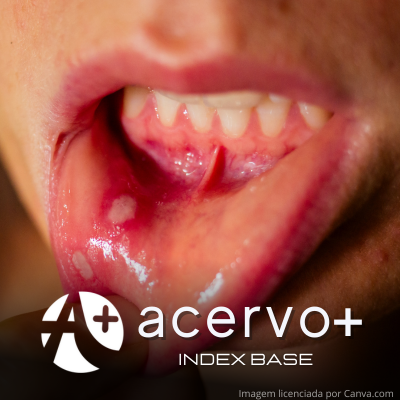Terapia de fotobiomodulação na prevenção do herpes labial recorrente
##plugins.themes.bootstrap3.article.main##
Resumo
Objetivo: Avaliar a eficácia da terapia de fotobiomodulação (TFBM) na prevenção do herpes labial recorrente (HLR). Métodos: Revisão integrativa da literatura com busca em bases de dados eletrônicas (Pubmed e Biblioteca Virtual em Saúde - BVS) entre 2012 e 2024. Foram incluídos ensaios clínicos randomizados e outros estudos relevantes, que compararam TFBM com terapias farmacológicas e analisaram desfechos, como redução de dor, tamanho das lesões e taxa de recorrência. A questão de pesquisa foi determinada seguindo a estratégia PICOS, com a pergunta norteadora: “Qual o protocolo clínico para a fotobiomodulação no tratamento da herpes labial recorrente?”. Resultados: A TFBM é eficaz na diminuição da frequência de recorrências, tamanho das lesões e intensidade da dor, especialmente quando combinada com antivirais. Protocolos com maior densidade de energia e maior número de sessões apresentaram melhores resultados, embora haja necessidade de padronização dos parâmetros terapêuticos. Considerações finais: A TFBM representa uma alternativa promissora, indolor e segura para a prevenção e manejo do HLR, mas estudos clínicos adicionais são necessários para consolidar sua eficácia e otimizar os protocolos.
##plugins.themes.bootstrap3.article.details##
Copyright © | Todos os direitos reservados.
A revista detém os direitos autorais exclusivos de publicação deste artigo nos termos da lei 9610/98.
Reprodução parcial
É livre o uso de partes do texto, figuras e questionário do artigo, sendo obrigatória a citação dos autores e revista.
Reprodução total
É expressamente proibida, devendo ser autorizada pela revista.
Referências
2. ARAIN N, et al. Effectiveness of topical corticosteroids in addition to antiviral therapy in the management of recurrent herpes labialis: a systematic review and meta-analysis. BMC Infect Dis, 2015; 15: 21.
3. BOES H, et al. A. Clinical study on the effectiveness of three products in the treatment of herpes simplex labialis. Sci Rep, 2020; 10(1): 15.
4. CHI CC, et al. Interventions for prevention of herpes simplex labialis (cold sores on the lips). Cochrane Database Syst Rev, 2015; 7.
5. DE CARVALHO RR, et al. Effect of laser phototherapy on recurring herpes labialis prevention: an in vivo study. Lasers Med Sci, 2010; 25(3): 397–402.
6. EDUARDO C de P et al. Prevention of recurrent herpes labialis outbreaks through low-intensity laser therapy: a clinical protocol with 3-year follow-up. Lasers Med Sci. 2012; 27(6): 1077-83.
7. GAIZEH AL-HALLAK MA, et al. Efficacy of photobiomodulation therapy in recurrent herpes labialis management: a randomized controlled trial. Clin Oral Investig, 2024; 28(2): 157.
8. GOLESTANNEJAD Z, et al. A novel drug delivery system using acyclovir nanofiber patch for topical treatment of recurrent herpes labialis: A randomized clinical trial. ClinExp Dent Res, 2021; 8(1): 184–90.
9. KHALIL M e HAMADAH O. Association of photodynamic therapy and photobiomodulation as a promising treatment of herpes labialis: a systematic review. PhotobiomodulPhotomed Laser Surg, 2022; 40(5): 299–307.
10. LA SELVA A, et al. Treatment of herpes labialis by photodynamic therapy: Study protocol clinical trial (SPIRIT compliant). Medicine, 2020; 99(12): 19500.
11. LA SELVA A, et al. Treatment of herpes labialis by photodynamic therapy. Medicine, 2020; 99(12): 19500.
12. LAGO ADN, et al. Resolution of herpes simplex in the nose wing region using photodynamic therapy and photobiomodulation. PhotodiagnosisPhotodyn Ther, 2018; 9(6): 729–32.
13. LAGOADN, et al. Association of antimicrobial photodynamic therapy and photobiomodulation for herpes simplex labialis resolution: case series. PhotodiagnosisPhotodynTher, 2020; 32: 102070.
14. LOTUFO MA, et al. Efficacy of photodynamic therapy on the treatment of herpes labialis: a systematic review. PhotodiagnosisPhotodynTher, 2020; 29: 101536.
15. MAZZARELLO V, et al. Do sunscreen prevent recurrent herpes labialis in summer? J DermatolTreat, 2018; 30(2): 179–82.
16. MS. MINISTÉRIO DA SAÚDE. Secretaria de Ciência, Tecnologia e Insumos Estratégicos, Departamento de Ciência e Tecnologia. Diretrizes metodológicas: elaboração de revisão sistemática e metanálise de ensaios clínicos randomizados. Brasília: Editora do Ministério da Saúde; 2012.
17. RAHIMI H, et al. Effectiveness of antiviral agents for the prevention of recurrent herpes labialis: a systematic review and meta-analysis. Oral Surg Oral Med Oral Pathol Oral Radiol, 2012; 113(5): 618–27.
18. RAMALHO KM, et al. Photodynamic therapy and Acyclovir in the treatment of recurrent herpes labialis: a controlled randomized clinical trial. Photo diagnosis PhotodynTher, 2021; 33: 102093.
19. SANTOS CM, et al. A estratégia PICO para a construção da pergunta de pesquisa e busca de evidências. Rev Latino-Am Enfermagem, 2007; 15: 508–11.
20. SCHINDL A e NEUMANN R. Low-intensity laser therapy is an effective treatment for recurrent herpes simplex infection. Results from a randomized double-blind placebo-controlled study. J Invest Dermatol, 1999; 113(2): 221–3.
21. SEYYEDI SA, et al. Efficacy of adjuvant photobiomodulation therapy in recurrent herpes labialis: a randomized clinical trial study. Photo diagnosis PhotodynTher, 2024; 49: 104282.
22. SILVA HM, et al. Aplicação da ozonioterapia na odontologia: revisão integrativa. Rev EletrAcervoSaúde, 2021; 13(8): 8648.
23. WHITLEY R e BAINES J. Clinical management of herpes simplex virus infections: past, present, and future. F1000Res, 2018; 7: 1726.

